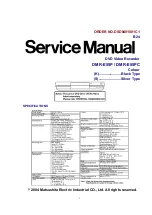
Glossary
AT&T mode
Berkeley and AT&T functional modes differ in “read-only” close functionality. In
AT&T mode, a device close operation will cause the tape to be repositioned just
after next filemark on the tape (the start of the next file).
Berkeley mode
Berkeley and AT&T functional modes differ in “read-only” close functionality. In
Berkeley mode the tape position will remain unchanged by a device close
operation.
BOT
Beginning Of Tape.
The first point on the tape that can be accessed by the drive.
buffered mode
A mode of data transfer in write operations that facilitates tape streaming. It is
selected by setting the Buffered Mode Field to 1 in the SCSI MODE SELECT
Parameter List header.
compression
A procedure in which data is transformed by the removal of redundant information
in order to reduce the number of bits required to represent the data. This is
basically done by representing strings of bytes with codewords.
In LTO drives, the data is compressed using the LTO-DC compression format
which is based on ALDC (licensed from Stac/IBM) with two enhancements. One
limits the increase in size of data that cannot be compressed that ALDC produces.
The other is the use of embedded codewords.
Fibre Channel
Fibre Channel provides an inexpensive yet expendable means of quickly
transferring data between workstations, mainframes, supercomputers, desktop
computers, storage devices, displays and other peripherals. Although it is called
Fibre Channel, its architecture represents neither a channel nor a real network
topology. It allows for an active intelligent interconnection scheme, called a
fabric, to connect devices. All a Fibre Channel port has to do is to manage a
simple point-to-point connection between itself and the fabric.
Several common ULPs (Upper Level Protocols) including IP and SCSI can run on
Fibre Channel, merging high-speed I/O and network functionality in a single
connectivity technology.
filemark
A mark written by the host to the tape that can be searched for, often using the
drive’s fast-search capability. It does not necessarily separate files. It is up to the
host to assign a meaning to the mark.
immediate mode
A mode of responding to SCSI commands where the drive or other peripheral
does not wait until the command has finished before returning status information
back to the host. For writing filemarks, Immediate mode can significantly improve
the performance of systems that do not set the Immediate bit when sending a
SCSI WRITE FILEMARKS command. On the other hand, data is not flushed to
tape in response to a filemark command.
infinite flush
By default, the buffer in the drive is flushed every 5 seconds. Infinite flush avoids
frequent starting and stopping of the mechanism when using a very slow
application. It also avoids losing capacity through the flushing of partly written
Volume 5: UNIX, Linux and OpenVMS configuration guide
39
Содержание EH890-90900
Страница 16: ...HP OpenVMS servers and workstations 16 ...
Страница 20: ...Linux servers and workstations 20 ...
Страница 30: ...Sun Solaris servers and workstations 30 ...
Страница 34: ...Verifying the installation 34 ...
Страница 42: ...W workstations OpenVMS 15 42 ...




































